I'm confused.
I don't recall one instance of 'getting it'.
I am trying to remember when I learned how to intelligently break up complicated services into smaller, simpler ones.
Also, those smaller, decomposed services should fit and work well together, like a glove fits a hand.
This skill is as rare as hen's teeth.
Gaining this one skill will make your systems elegant and beautiful. It's a developer superpower.
And today, I'll show you how to do it.
Example: CustomerEmailer
Below is a C# listing for sending new customers a Welcome email. Its structure is typical for programmers with less experience. As a junior developer, I wrote code just like it.
It works well enough but has some issues:
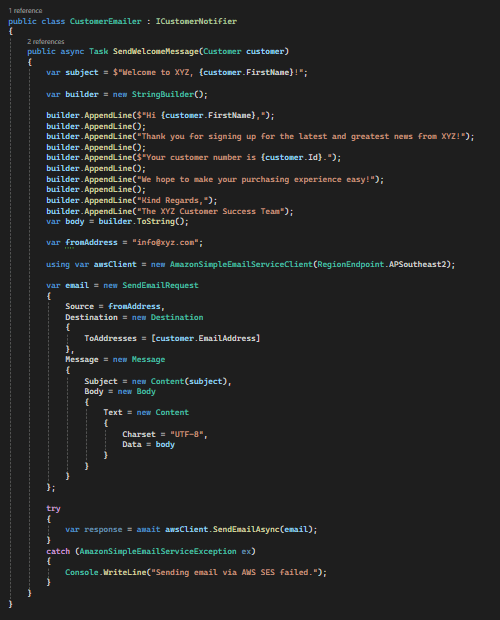
What are the problems with this method?
To maximise your learning experience, stop reading, grab pen and paper and take 5 minutes to identify the code issues before reading on.
Alright, here are my main concerns:
- The email subject and body are hard-coded. Every time the email text changes, the code must be recompiled and redeployed.
- The sending email address is hard-coded. Whenever this address changes, the code must again be rebuilt and redeployed.
- The AWS region is hard-coded. The method instantiates a AmazonSimpleEmailServiceClient for a fixed AWS region, RegionEndpoint.APSoutheast2. If we ever need to change this region, CustomerEmailer must be recompiled and redeployed.
- The use of AWS SES for sending emails. What about sending these emails via another technology, like SMTP or Azure Communication Services? Such a change would require invasive modifications. And (yet again!) the code would need to be recompiled and redeployed.
SendWelcomeMessage() will likely need modifications and redeployment in the future.
Can we restructure CustomerEmailer, so that none of the outlined and expected behaviour changes require code modifications in this class?
Yes, it's possible to pull this off!
We must make CustomerEmailer pluggable and delegate much of its current work to other services, i.e. service decomposition!
Let me show you how to do this:
Look up an Email Template
One of the things that irks me most is the hard-coded email body. As you can imagine, email text changes at the drop of a hat.
We want to move the email template body and subject text to another place, be it a database, a JSON file, a remote service or something else entirely. It must be an email template, as hard-coding customer names and other dynamic properties won't work.
Furthermore, we need access to a place holding email templates we can look up by name, such as "Customer Welcome," for a customer welcome email.
Let's abstract away this repository of email templates as IEmailTemplateRepository, including a method to look up templates by name:

Look up Email Sender
The email sender may change from time to time. It would be downright dorky to alter and redeploy the code when that happens.
No, rarely changing values, like sending email address, belong in system configuration.
Since the configuration technology can also vary (e.g. config file, database, service) let's abstract it away with an IEmailConfiguration interface:
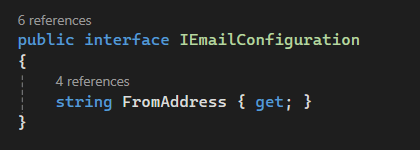
Getter property FromAddress retrieves the sending email address.
Nice!
What's next?
Replacing Placeholders
Now that we can retrieve an email template by name (e.g. "Customer Welcome"), we will want to turn the template into a concrete email for a given recipient customer.
We must replace all placeholders in the email with the correct customer specifics:
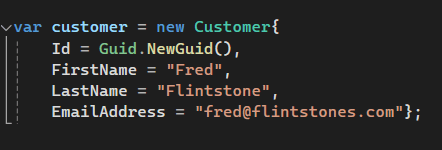
If the customer is "Fred Flintstone" and a templated email subject of "Welcome to XYZ, [[FirstName]]!" should replace [[FirstName]] with the customer object's FirstName property: "Welcome to XYZ, Fred!".
Accordingly, we have a requirement for a PlaceholderReplacer to replace placeholders embedded within the email template subject and body with customer information.

Sending the Email
While the current CustomerEmailer implementation sends the formatted customer Welcome email with AWS Simple Email Service (SES), that may change.
It's in our system's (and our company's) interest to retain a high degree of independence from specific technologies.
Consider how much effort would be required to modify the code to send emails through a different cloud service platform. Currently: A bit. Ideally: Zero, or at most a config change.
How do we decompose the generic emailing behaviour?
How about via an IEmailer interface:
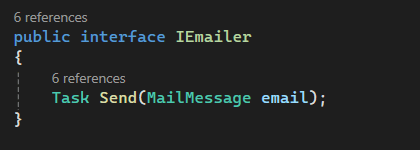
That's it.
Now we can plug an AwsEmailer, an AzureEmailer, or an SmtpEmailer into this interface with IoC configuration!
Putting it Together
Here is the new, improved CustomerEmailer:
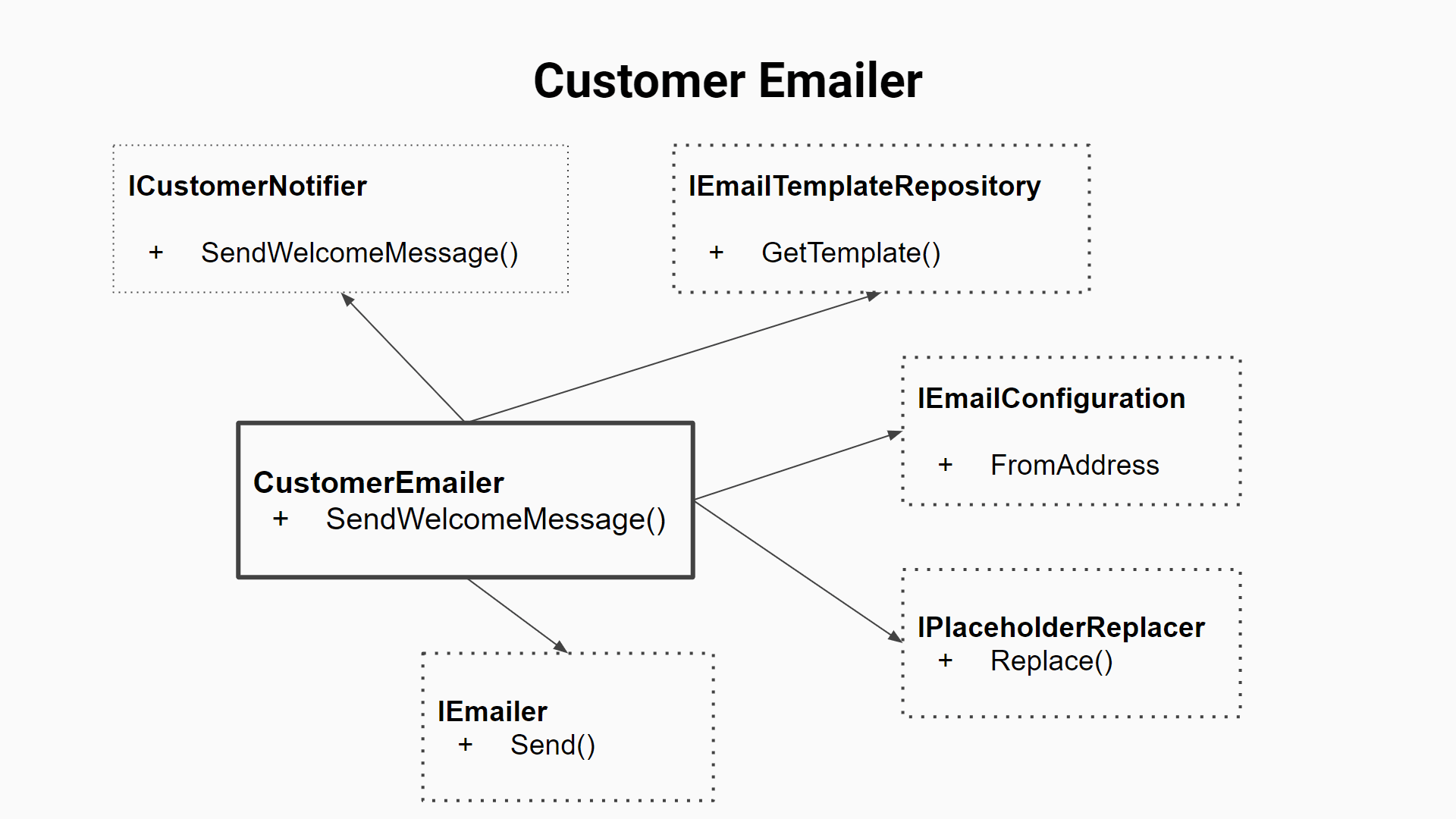
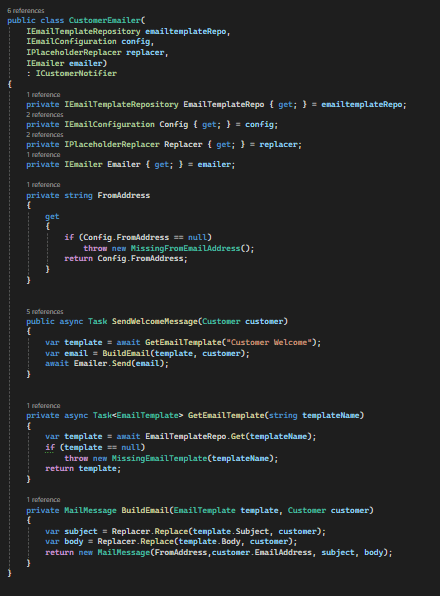
To summarise:
- Email template store. Emails are templated, keyed by name, stored in a repo and retrievable from the repo. The repo can be anything that implements IEmailTemplateRepository, like a Postgres database or a JSON file.
- Infrequently changing values, like sending email address, are now stored in configuration. Once again, implementations can vary.
- A service for replacing placeholders, which is also abstracted. However, a concrete and reusable PlaceholderReplacer, is available with the code accompanying this example.
- Last, the generic emailing technology has been extracted and put behind an IEmailer interface. The code provides a separate AwsEmailer implementation, for which the AWS region is separately configurable!
Conclusion
So, what cognitive work must happen before we can decompose services?
- We need to recognise if an aspect of our code is overly specific and that this specific-ness will hurt us later when we need to implement different specific behaviour that the existing code cannot fulfil. Think of the hard-coded email text, which is likely to change in the future.
- Next, we might consider solutions that relax the specific-ness of our current situation, to the point where we have solved the problem in general. E.g. Email templates with placeholders that are replaced with customer information.
- Decompose the component services along those lines. Interfaces should have abstract general names, like IEmailer, while implementers have specific ones, like AwsEmailer.
- Revel in the Lego-like reusability of your code. Consider the value of a general PlaceholderReplacer and specific and pluggable emailers, like an AwsEmailer! This component could be useful whenever requirements call for an emailing solution.

